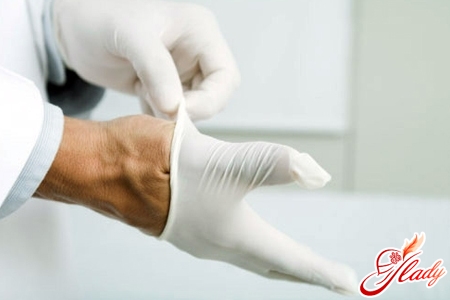 Laparoscopy of ovarian cyst is one ofthe most common gynecological operations - it accounts for about two thirds of all surgical interventions in the female reproductive system. However, despite such a wide distribution, not all women have sufficient information about the disease itself, as well as about the method of its treatment - laparoscopy. But it is the lack of necessary information that leads to the fact that a woman does not notice the problem in time, and before laparoscopy she worries much more than the one who knows exactly what the doctors will do with her during the intervention. After all, as a rule, the unknown causes much more fear than the procedure itself.
Laparoscopy of ovarian cyst is one ofthe most common gynecological operations - it accounts for about two thirds of all surgical interventions in the female reproductive system. However, despite such a wide distribution, not all women have sufficient information about the disease itself, as well as about the method of its treatment - laparoscopy. But it is the lack of necessary information that leads to the fact that a woman does not notice the problem in time, and before laparoscopy she worries much more than the one who knows exactly what the doctors will do with her during the intervention. After all, as a rule, the unknown causes much more fear than the procedure itself.
What is a cyst?
Before I tell you what it islaparoscopy and how it is performed, we should talk a little about what an ovarian cyst is, because it is the main indication for surgical intervention. So, an ovarian cyst is a cavity formed in the body of the ovary, inside of which there is a certain amount of fluid. And pay attention - this cavity does not look like a growth formed on the surface of the ovary, but grows inside its body. The size of an ovarian cyst can be very different - from very small to very, very huge. Sometimes there is only one cyst in the ovarian cavity, and sometimes there are quite a lot. In the second case, the disease is called polycystic ovary disease. As a rule, to remove an ovarian cyst, doctors are forced to resort to laparoscopy. However, sometimes a cyst in the ovary resolves completely on its own, without any intervention from doctors, and just as unexpectedly as it appears. However, if such cysts occur regularly, the doctor may decide to conduct a special course of hormonal therapy. Such cysts are formed from the connective tissues of the ovary body itself – and they do not require surgical removal. This type of cyst is called functional. There is another group of cysts that, unfortunately, can only be removed surgically. If such a cyst is not removed, it will rapidly grow and eventually inevitably lead to a rupture of the ovary itself – a condition that threatens not only the woman’s health, but also her life. Such cysts are called organic. So, a little more about them:
- Functional ovarian cyst
The culprits of the development of a functional cyst are:As a rule, there are several factors at once - a weakened immune system, dysfunction of the ovary itself, and hormonal imbalance in the body. This type of ovarian cyst occurs quite often, but fortunately, they resolve on their own quite quickly - a maximum of two months, at the beginning of the third menstrual cycle after formation. Such functional cysts are diagnosed using the most common ultrasound examination. Since they do not require removal, doctors do not use laparoscopy to diagnose functional cysts.
- Organic Ovarian Cysts
In the event that after two months afterdetection of a cyst, doctors' observations will show that the cyst has not even begun to resolve, doctors assume that the cyst is not functional at all, which means that it requires much more serious treatment. An organic cyst is a dense capsule - a hard shell and the fluid contained in it. Such a cyst can be located anywhere in the ovary - both on its surface and in its body. Such a cyst can grow very, very quickly - in just a couple of weeks it can increase in size by two or even three times. It is necessary to remove such cysts as quickly as possible, otherwise there is a very high risk that a rapidly increasing cyst will sooner or later lead to serious damage to the ovary itself.
- Polycystic ovary
In the event that a doctor finds in a woman's ovariesdetects several cysts at once, we are talking about polycystic disease. Incidentally, it is polycystic disease that very often leads to the development of infertility. Polycystic disease makes itself known with the following symptoms - menstrual irregularities, excess weight, increased amount of hair on a woman's body. As a rule, it is quite difficult to get rid of polycystic disease with conventional hormonal therapy, and sometimes it is completely impossible, so doctors most often resort to laparoscopy.
Laparoscopy for ovarian cysts
So, the conversation came to the most important thing –laparoscopy itself. As is already clear from the above, laparoscopy is necessary to remove ovarian cysts. Many women are afraid of undergoing surgery, but it is simply necessary to prevent a number of very negative complications of this disease:
- Bowel rupture
It has already been mentioned several times above thatThe greatest danger that an ovarian cyst poses is a rapid increase in size, which leads to disruption of the normal functioning of the ovary and even its rupture and extensive internal bleeding. In addition, if the ovary is damaged, it will have to be completely removed, which will lead to the development of infertility.
- Torsion of the ovary
The ovary is located on a low stalk, whichis necessary for blood and nutrients to enter it. A cyst often leads to the ovarian stalk being completely twisted, and as a result, tissue death occurs quite quickly.
- Development of pathological tissues
As the cyst grows, it absorbsmore and more healthy ovarian tissue, replacing it with pathological growths. In some particularly unfavorable cases, the presence of a cyst can become a trigger for the development of ovarian cancer. Until recently - almost a few years ago, laparoscopy was performed much less often. And as a result, even with a small two-three-centimeter cyst, doctors were forced to resort to a fairly serious abdominal surgery. In recent years, even a very small cyst can be removed without resorting to abdominal surgery, using laparoscopic equipment, without any consequences for the general condition of the woman's body. In just a few hours, a woman can completely forget about all the troubles associated with such a disease as an ovarian cyst. The main goal of this disease is to remove the cyst from the membranes without damaging the tissue of the ovary itself. Gynecologists, explaining to women the principle of the operation itself, cite the example of peeling a tangerine - it must be peeled in such a way as not to damage the contents of the fruit. The same applies to the operation to remove the cyst - it must be completely removed from the woman's body without damaging its membrane - otherwise it will spread throughout the abdominal cavity - and at the same time without damaging the healthy tissues of the ovary. In particularly severe cases, the doctor may decide to perform a slightly different type of laparoscopy - wedge resection. During such an operation, the doctor removes a small section of the ovary itself along with the cyst.
Choosing a doctor
Many women are panicky afraidlaparoscopy, and in vain. In fact, laparoscopy is currently one of the most effective and safe ways to treat ovarian cysts. The most important thing you need to do is to choose a good and experienced doctor for whom laparoscopy is not something out of the ordinary. The most important thing that is necessary for a successful laparoscopy is the accuracy and precision of the doctor's movements. This is what determines whether you will be able to have children after this, as well as what the risk of a relapse of the disease will be - the development of new cysts. As mentioned above, laparoscopy itself is a fairly simple operation, but it requires increased attention, accuracy and precision of movements from the doctor performing the operation. After the cyst capsule is cleared, the doctor must stop the bleeding from the ovarian vessels, using special power tools for this purpose. And in order for healthy tissues not to be injured as a result of exposure to electric current and high temperatures, the ovary must be continuously cooled by wetting with special distilled water. Another important point that must be taken into account is the choice of the doctor - anesthesiologist. After all, it depends on him how correctly the anesthesia will be done during the surgical intervention. As a rule, doctors prefer to do laparoscopy under local anesthesia, without resorting to general anesthesia. However, in rare cases, the doctor may still decide on the need for general anesthesia if the patient's condition gives rise to any concerns. This is why it is so important to choose a competent anesthesiologist who will adequately assess the woman's condition and select the best option for anesthesia. The ovary recovers very quickly - its borders take on their usual shape and size on about the second day. And the ovary begins to perform its functions after one week, and sometimes even earlier. And the woman herself recovers from the operation very, very quickly - literally the next day she can already lead her usual way of life - play sports, go to work, do housework. That is why in most cases, if the general health condition of the woman is not burdened by any complications, the operation is performed on an outpatient basis, without the woman’s mandatory hospitalization.
Other indications for ovarian laparoscopy
However, an ovarian cyst is far from the only thingindication for laparoscopic intervention in the female reproductive system. For example, laparoscopy is often prescribed by a doctor to a woman suffering from endometriosis. Endometriosis is a serious enough disease that affects not only the body of the uterus, but also the ovaries. By the way, there is another type of ovarian cyst - an endometrioid cyst, which, fortunately, is extremely rare. This cyst leads to a significant deterioration in the general condition and well-being of a woman - she may have a slight fever for a long time, general weakness, menstrual irregularities, infertility. And in this case, laparoscopy of the ovaries is necessary in order to completely excise the adhesions that arise as a result of endometriosis. In addition, laparoscopy is often used as a diagnostic examination method. The doctor makes a small puncture in the woman's abdominal cavity, after which he inserts a special probe, with the help of which all the necessary information is obtained. And another case that very often requires laparoscopy is an ectopic pregnancy. If an ectopic pregnancy is detected in a timely manner, it is with the help of laparoscopy that doctors remove the fetus from the fallopian tube. Thus, doctors manage to remove the fetus without damaging either the fallopian tubes or the abdominal tissue, as is usually the case with abdominal surgeries. To summarize today's conversation, it should be noted that today the most painless, effective and safe way to restore the health of a woman's reproductive system is laparoscopy. Therefore, if at your next preventive examination your gynecologist tells you that you have an ovarian cyst, laparoscopy will help you get rid of the problem in the shortest possible time, and with virtually no negative consequences. We recommend reading:









